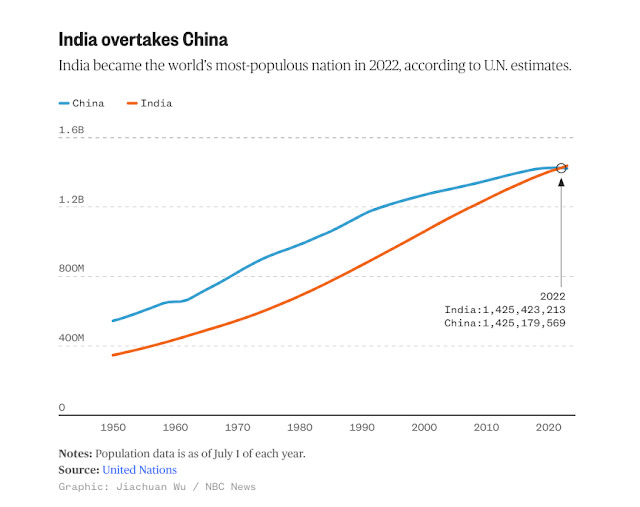Report: World Population Report 2024 - What graphics from the U.N. population report shows about us and our future on this planet: Denise Chow et al. / NBC News
"“The demographic landscape has evolved greatly in recent years,” Li Junhua, undersecretary-general for economic and social affairs at the United Nations, said in a news release.
"The report forecasts that the world’s population will continue to swell over the next several decades — growing from 8.2 billion people in 2024 to a peak of nearly 10.3 billion people in 50 to 60 years. But it won’t grow forever: The global population is expected to return to 10.2 billion people by 2100, which is 6% lower than what the U.N.’s experts had projected a decade ago.
"The U.N.’s previous population assessment, released in 2022, suggested that humanity could grow to 10.4 billion people by the late 2000s, but lower birth rates in some of the world’s largest countries, including China, are among the reasons for the earlier-than-anticipated population peak.
"More than half of all countries have a fertility rate less than 2.1 births per woman, or what’s known as the “replacement rate,” because it’s the number of children that each woman would need to have, on average, to keep the population from declining.
"Forty-eight more countries, including Vietnam, Brazil, Turkey and Iran, are expected to see their populations peak over the next 30 years."
Click here for the article
Click here for the report
"The report forecasts that the world’s population will continue to swell over the next several decades — growing from 8.2 billion people in 2024 to a peak of nearly 10.3 billion people in 50 to 60 years. But it won’t grow forever: The global population is expected to return to 10.2 billion people by 2100, which is 6% lower than what the U.N.’s experts had projected a decade ago.
"The U.N.’s previous population assessment, released in 2022, suggested that humanity could grow to 10.4 billion people by the late 2000s, but lower birth rates in some of the world’s largest countries, including China, are among the reasons for the earlier-than-anticipated population peak.
"More than half of all countries have a fertility rate less than 2.1 births per woman, or what’s known as the “replacement rate,” because it’s the number of children that each woman would need to have, on average, to keep the population from declining.
"Forty-eight more countries, including Vietnam, Brazil, Turkey and Iran, are expected to see their populations peak over the next 30 years."
Click here for the article
Click here for the report





Comments
Post a Comment
If you are a member of XUNICEF, you can comment directly on a post. Or, send your comments to us at xunicef.news.views@gmail.com and we will publish them for you.